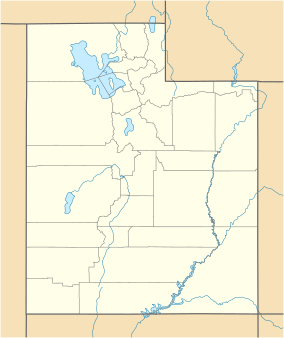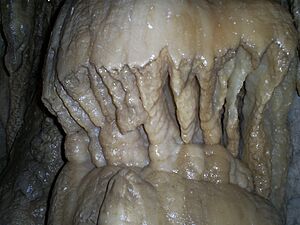Timpanogos Cave National Monument facts for kids
Quick facts for kids Timpanogos Cave National Monument |
|
|---|---|
|
IUCN Category III (Natural Monument)
|
|
| Location | Utah County, Utah, United States |
| Nearest city | Highland, Utah |
| Area | 250 acres (100 ha) |
| Created | October 14, 1922 |
| Visitors | 96,965 (in 2011) |
| Governing body | U.S. National Park Service |
| Website | Timpanogos Cave National Monument |
Timpanogos Cave National Monument is a special place in Utah, United States. It protects a cool system of caves located inside Mount Timpanogos. This area is part of the Wasatch Range mountains, near Highland, Utah. The National Park Service manages and protects this amazing natural wonder.
To reach the caves, you hike a 1.5-mile trail. It goes up about 1,092 feet, which is like climbing a tall building! But the path is paved and wide, so most people can enjoy the walk. You can only see the caves on guided tours. These tours usually run from May through September, depending on snow and other conditions. Besides the regular tour, there's also an "Introduction to Caving" tour. This special tour teaches you how to explore caves safely and without leaving any trace behind.
Contents
Exploring the Caves
The monument has three main caves you can explore: Hansen Cave, Middle Cave, and Timpanogos Cave. In the 1930s, people built tunnels to connect these three caves. This makes it easier to explore them all on one tour. The temperature inside the caves stays cool, around 46 degrees Fahrenheit (about 8 degrees Celsius).
Inside the caves, you'll see many colorful and unique rock formations. These are called speleothems. One of the most interesting types is the helictite. These look like hollow, twisted straws made of minerals like calcite. They form when water slowly drips and evaporates, leaving tiny mineral deposits.
Other cool formations you might see include:
- Cave bacon: Thin, wavy sheets of rock that look like bacon.
- Cave columns: When a stalactite (hanging from the ceiling) and a stalagmite (growing from the floor) meet and join together.
- Flowstone: Sheets of rock that look like frozen waterfalls.
- Cave popcorn: Small, bumpy mineral deposits that look like popcorn.
- Cave drapery: Thin, curtain-like sheets of rock.
- Stalactites: Icicle-shaped formations that hang down from the cave ceiling.
- Stalagmites: Cone-shaped formations that grow up from the cave floor.
How the Caves Were Found
The story of how these caves were discovered is quite interesting!
Hansen Cave Discovery
In October 1887, a man named Martin Hansen found the first cave, now called Hansen Cave. He was reportedly tracking cougar footprints high up in American Fork Canyon when he stumbled upon it. Sadly, before the cave became a national monument, many of its beautiful formations were damaged or taken by people.
Timpanogos Cave Discovery
Years later, in the summer of 1913, two teenagers, James Williams Gough and Frank Johnson, found a second cave. They were exploring near Hansen Cave when they discovered the entrance to what is now Timpanogos Cave. Many people saw the amazing formations inside, like the "Great Heart of Timpanogos." However, the entrance to this cave was later lost. Some say a landslide covered it, while others believe the original discoverers kept its location a secret.
In 1921, a group called the Payson Alpine Club, led by Vearl James Manwill, went looking for the lost cave. On August 14, 1921, Vearl rediscovered it. Knowing how Hansen Cave had been damaged, his group immediately decided to protect this new cave. They wanted to "preserve its beauty for future generations." Soon after, they told the United States Forest Service about their find.
Middle Cave Discovery
Just a few months later, in October 1921, Martin Hansen's son, George Heber Hansen, and his grandson, Wayne Errol Hansen, found a third cave. They were hunting and saw a hole in the mountain between the other two caves. A few days later, they returned with 74-year-old Martin Hansen, who was the first to enter this new cave, now called Middle Cave.
Today, tours enter the cave system through a man-made entrance near the original Hansen Cave entrance. You walk through tunnels connecting all three caves, ending your tour by exiting near the original Timpanogos Cave entrance.
Managing the Monument
Timpanogos Cave was made a national monument on October 14, 1922. At first, the U.S. Forest Service managed it. But in 1933, the National Park Service took over. Many of the buildings and paths you see today were built in the 1930s and early 1940s by a group called the Works Progress Administration. These historic structures are now part of the Timpanogos Cave Historic District.
The National Park Service works hard to protect the caves and their natural features. For example, they limit the lighting inside the caves. This helps stop the growth of things like algae that shouldn't be there. Protecting the caves is a top priority. They carefully balance allowing visitors to see the caves with making sure the caves stay healthy and natural. That's why they limit the number of people on each tour.
In 1991, the monument's original visitor center burned down. For almost 30 years, the visitor center was in a temporary trailer. This trailer was in a dangerous spot where rocks could fall. So, plans were made for a new visitor center. Construction on the new visitor center and trail began in September 2018. The trail and monument reopened to the public in June 2019.
How the Caves Formed
The Timpanogos Cave system is found in a type of rock called limestone. This limestone formed about 340 million years ago! The caves themselves started to form because of cracks in the rock called faults. These faults are like big breaks in the Earth's crust.
Over millions of years, hot water (called hydrothermal water) moved through these cracks, slowly dissolving the rock and creating the cave passages. As the Wasatch Mountains slowly lifted up, the caves were also lifted higher. The beautiful rock formations (speleothems) inside the caves started to grow within the last 750,000 years. This happened as the caves were lifted above the stream that flows through the canyon.
See also
 In Spanish: Monumento nacional de la Cueva de Timpanogos para niños
In Spanish: Monumento nacional de la Cueva de Timpanogos para niños





